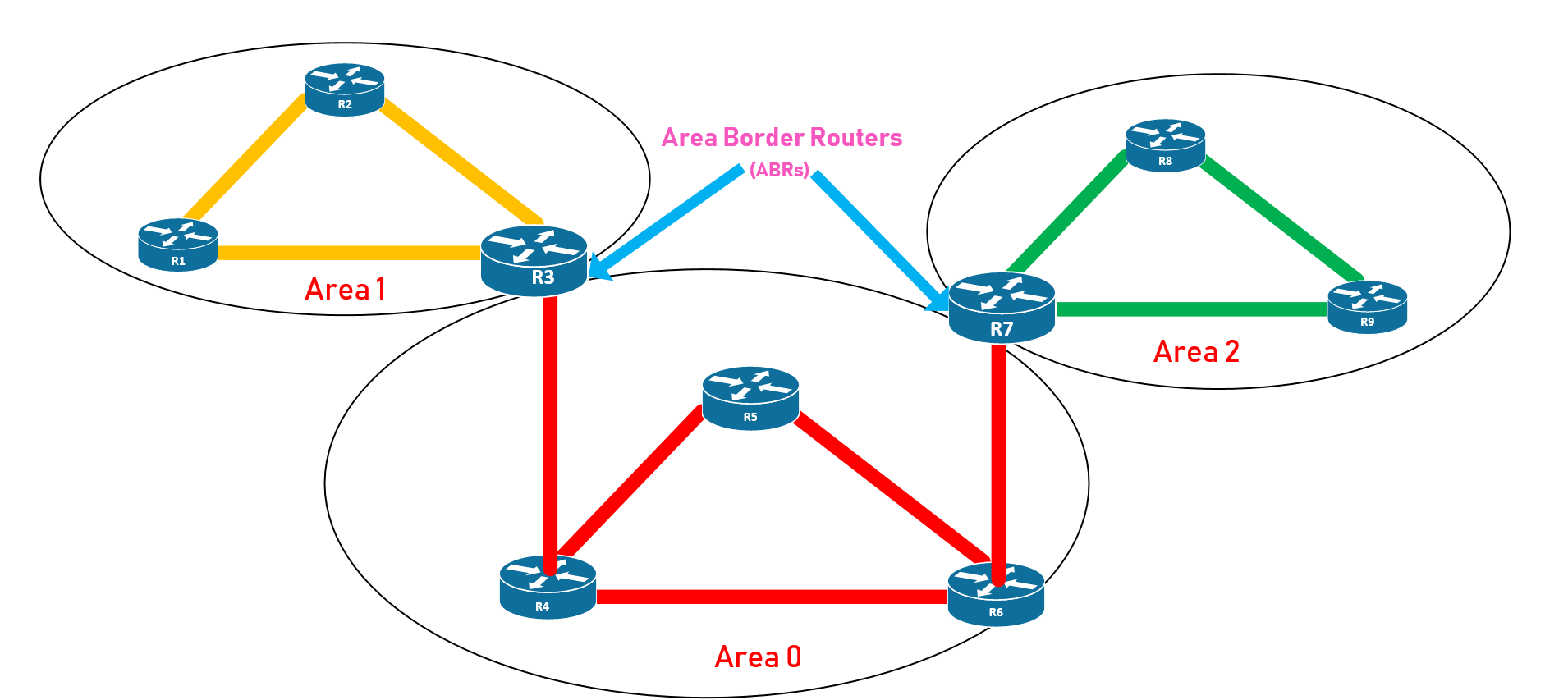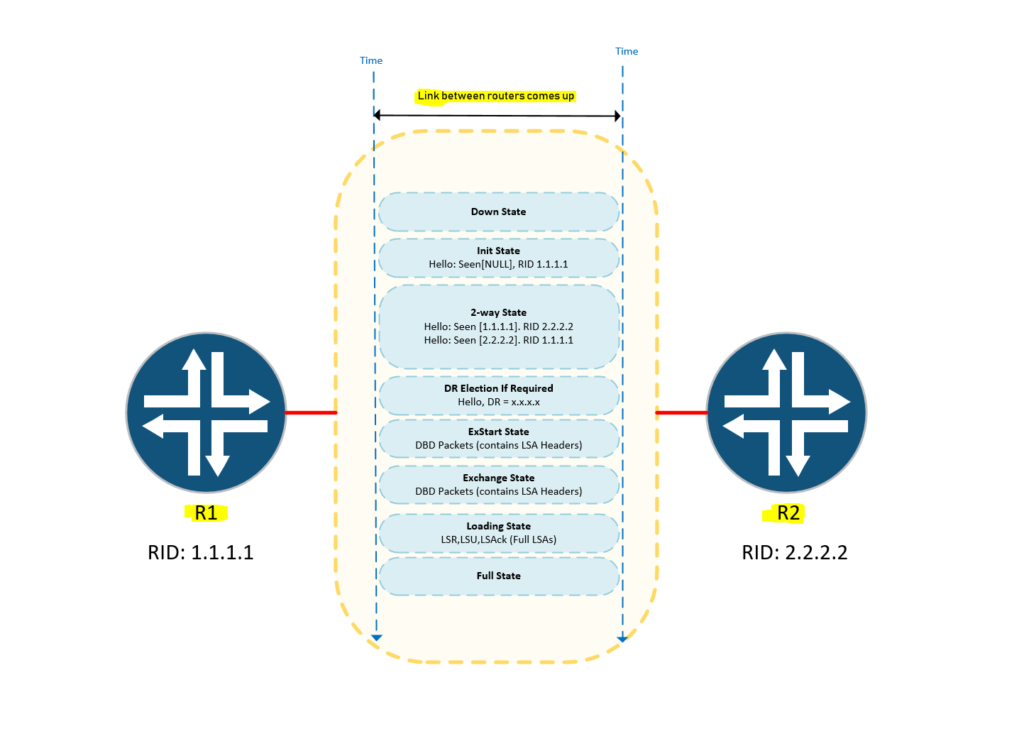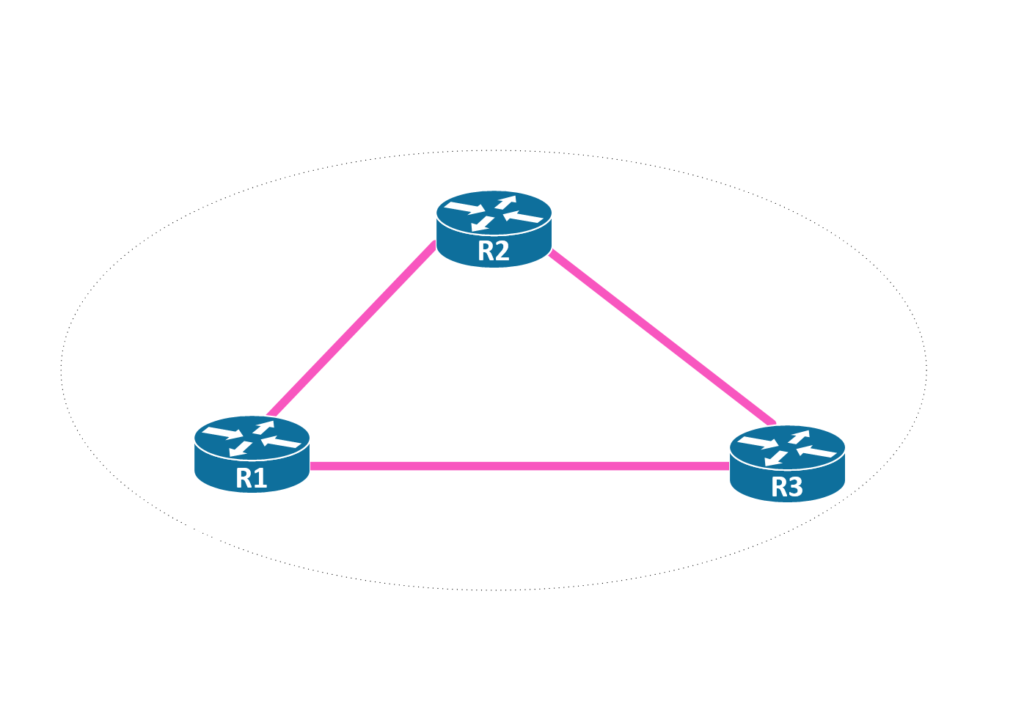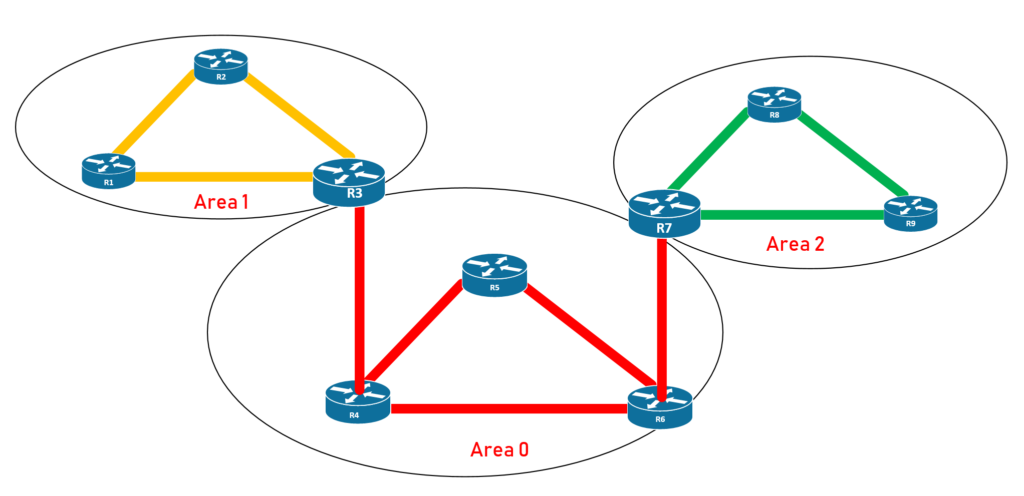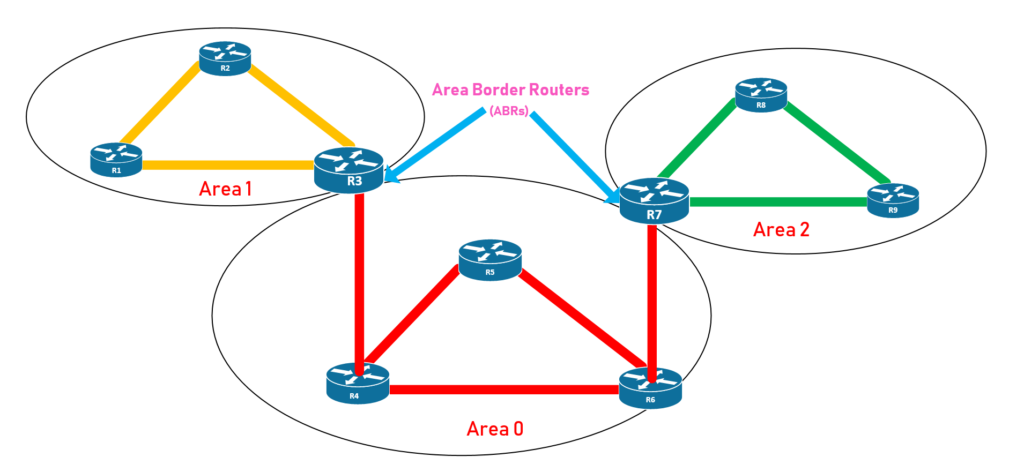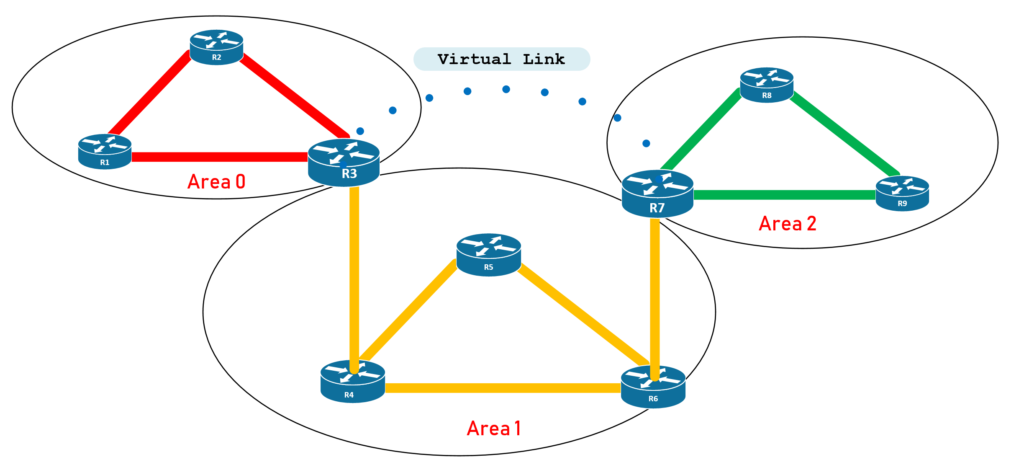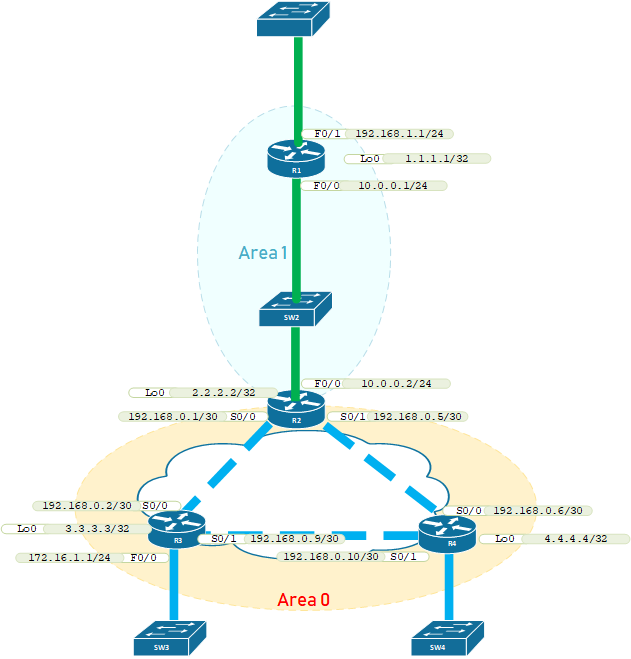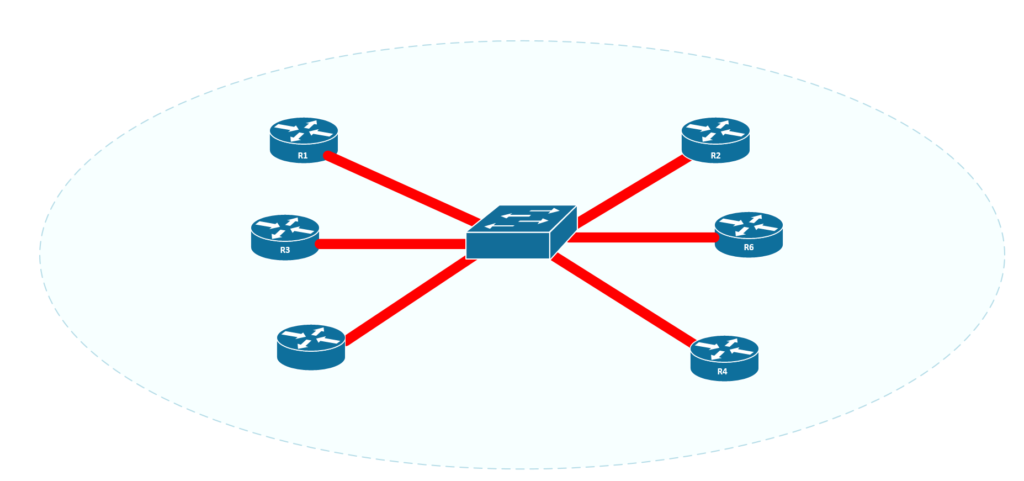Fundamental OSPF Concepts Introduction – Understanding OSPF and how to Configure it.
OSPF Fundamentals
This is a routing protocol you would have been introduced to in your CCNA studies.
OSPF is a link state routing protocol as opposed to EIGRP as a distance routing protocol open standard from the IETF. OSPF can establish adjacencies with other routers. These adjacencies is what allows the routers to send link state updates between one another. OSPF routers sends link state advertisements(LSAs) to other routers in an area. OSPF routers recieves LSAs and is able to construct a link state database from them.
The routers runs the Dijkstra Shortest Path First(SFP) algorithm to determine the shortest path to a network. OSPF attempts to inject the best path for each network into a router’s IP routing table.
Video: The Ultimate Guide to Understanding and Configuring OSPF
OSPF Neighbor Formation
Neighborship vs Adjacency
Although these terms are often used interchangeably, there is a technical distinction that must be clarified elaborately to contrast their differences.
Figure 1.0 – The Ultimate OSPF Configuration Guide
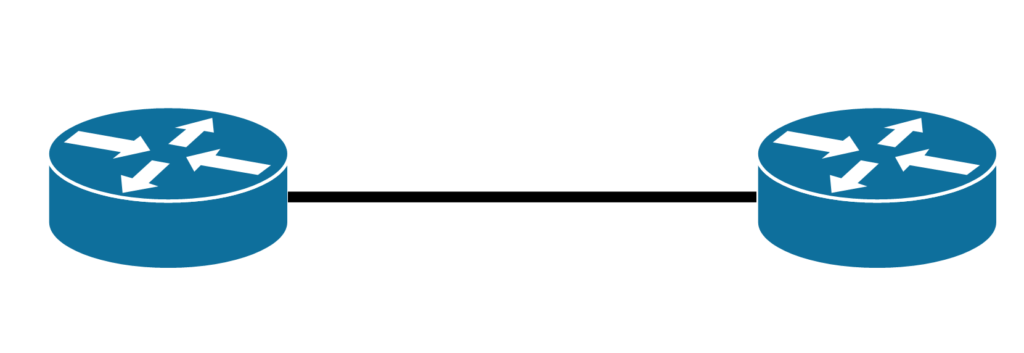
Neighbors are routers that:
Reside on the same network link (meaning that the routers are connected via a switch and able to speak within a subnet)
Exchange Hello messages. These routers residing on the same link exchange Hello Messages by sending Hellos to a Destination OSPF Routers Multicast address 224.0.0.5. This ability to exchange Hellos in itself is able to form neighborship although no
Link State Advertisements have been exchanged by these Neighbors, the truth is that they do not necessarily do that.
Adjacencies are routers that:
- Are Neighbors
- Exchange Links State Updates.
let us look at these states:
- State 1: Link Down
- State 2: Link Comes Up
- State 3: Init (Router 2 receive a Hello from Router 2 and recognises that its own Route ID is not in the received Hello message list of Routers known to Router 1.
- Router 2 realises that the Hello is from a Neighbor). At this state, it also sends a Hello to Router 1 which also checks the Hello and recognises its Router ID and realises it has been listed as a Neighbor.
- State 4: Since Router 1 has recognised a Neighbor, it transitions to a 2-WAY State. It now sends a Hello message back to Router 2 and upon receipt of this Hello message, Router 2 recognises its own Router ID listed as a Neighbor and as a result, Router 2 goes into a 2-Way State.
- Stage 5: At this stage both routers are in the 2-Way State and therefore where needed a DR/BDR Election takes place. DR means Designated Router and BDR means Backup Designated Router. Some OSFP types do not require this election process.
- State 6: At this ExStart stage the Primary and Secondary Routers are selected.
- Stage 7: At this Exchange state the Database Description Packets are Exchanged. These are exchange between the primary and secondary routers. The Database Description Packet is a list of LSAs known to the router which sends it.
- Stage 8: At this Loading state the Routers Query One Another (Using LSRs) Link State Requests for Missing Entries (sent in Link State Update Packet).
- Stage 9: At the Full state, the Routers have fully formed adjacency.
Figure 1.0 – Link States in a Typical OSPF Neighborship
OSPF Areas
When setting up an OSPF network, one of the things to configure is an Area assignment.
OSPF uses the concept of areas to carve up a network. We could just do with a single area. The Dijsktra SPF will be ran against the area. But for scalabilty reasosn, many coporate networks like to design very large networks with multiple areas. In such designs, the dijsktra SPF is run against each Area which in effect reduces computational load on the routers responsible to running the large dijsktra algorithm.
In a multiarea topology, there has to be a Backbone Area, and this is normally called a backbone area or Area 0. I almost said Area 51, but that is all the way in Mexico so let’s stick with Area 0. The backbone area typically numbered 0 or decimal as 0.0.0.0 is the area which all other areas directly connect. In simple terms, you cannot have Area 1 and 2 without an Area 0. Every design starts with Area 0.
KeyPhrase: In a Multiple Area Design, the Dijkstra Algorithm runs on the Link State Database for each area.
As you can see from Figure 1.1, all the areas are connected to Area 0. To be able to do this, each area will need to be touching Area 0. So looking at Figure 1.1 again, we can identify two Routers, Router3 and Router7 where each of these have interfaces belonging to the Backbone Area and their home areas. Router 3 has an interface in Area 1 as well as Area 0.
Quick question to you, Which areas does Router 7 have interfaces connecting to?
The Routers in Area 0 for example does not need to know of every interlink between routers in Area 1 but must know how to get to that Area 1 subnet and which router to use as the gateway or route to that Area. When the topology is too big, it is only a better idea to break them down into areas which will make computational processor much more efficient. This is true for systems where older router technology was used as today’s routers are more powerful and so a multi area ospf topology not needed.
But what helps is the fact that since OSPF is supported by many vendors, you could decide to put that vendor party in a dedicated OSPF Area for performance reasons.
The Single Area design works well and mostly used by many enterprises.
In a situation where the areas are not directly touching Area 0, although not recommended by Cisco, a Virtual Link can be used to create the connection to Area 0 for Area 2 in Figure 1.2
R7 has a Virtual Link transiting Area 1 into Area 0 and likewise, R3 transits Area 1 to get into Area 2.
A Virtual Link is a logical link that interconnects the backbone area with an area that is not adjacent to the backbone area. The Virtual link makes it appear that Area 2 is connected to the Backbone Area also known as Area 0 or 0.0.0.0.
Basic OSPF Configuration Example
Allow me to let you in on a big secret. When it comes to configuring Routing Protocols, plan well before jumping into configuring. I have created the table below as a good guide to help you configure OSPF anywhere with ease. Yes, I know, thank me later!
The table below identifies the areas and the routers and their interfaces as well as subnets belonging to the relevant areas.
Figure 1.3 – Identify Subnets and Interfaces Belonging to the OSPF Areas (Click on Image to Zoom In)
Figure 1.4 – Identified Interfaces on Routers and their Subnets
Let’s dive straight into configuring OSPF on all Routers.
On Router 1
R1#show run | begin router ospf ! router ospf 1 network 1.1.1.1 0.0.0.0 area 1 network 10.0.0.0 0.0.0.255 area 1 network 192.168.1.0 0.0.0.255 area 1 !
On Router 2
R2-ABR#show run | begin router ospf router ospf 1 network 2.2.2.2 0.0.0.0 area 1 network 192.168.0.0 0.0.0.3 area 0 network 192.168.0.4 0.0.0.3 area 0 !
Configuring OSPF for an Interface
This is another method in getting an interface to participate in the OSPF Process- By issuing the command on the interface directly.
R2-ABR#show run int f0/0 Building configuration... Current configuration : 111 bytes ! interface FastEthernet0/0 ip address 10.0.0.2 255.255.255.0 ip ospf 1 area 1
On Router 3
Let us configure OSPF on this router in a different way, Instead of specifying the subnets, let us be generic by telling OSPF that every active upstate interface must become part of the OSPF Process by issuing the command network 0.0.0.0 255.255.255.255 area 0
R3#show run | begin router ospf router ospf 1 network 0.0.0.0 255.255.255.255 area 0 !
On Router 4
R4#show run | begin router ospf router ospf 1 network 172.16.2.0 0.0.0.255 area 0 network 192.168.0.4 0.0.0.3 area 0 network 192.168.0.8 0.0.0.3 area 0
Can we now see the OSPF routes?
R2-ABR#show ip route ospf
1.0.0.0/32 is subnetted, 1 subnets
O 1.1.1.1 [110/11] via 10.0.0.1, 00:16:27, FastEthernet0/0
3.0.0.0/32 is subnetted, 1 subnets
O 3.3.3.3 [110/65] via 192.168.0.2, 00:17:02, Serial0/0
172.16.0.0/24 is subnetted, 2 subnets
O 172.16.1.0 [110/74] via 192.168.0.2, 00:17:02, Serial0/0
O 172.16.2.0 [110/74] via 192.168.0.6, 00:17:02, Serial0/1
192.168.0.0/30 is subnetted, 3 subnets
O 192.168.0.8 [110/128] via 192.168.0.6, 00:17:02, Serial0/1
[110/128] via 192.168.0.2, 00:17:02, Serial0/0
O 192.168.1.0/24 [110/20] via 10.0.0.1, 00:16:27, FastEthernet0/0
OSPF Verification
Let’s perform a verification of OSPF on Router 2 as it’s an Area Border Router and will have knowledge of the InterArea Routes.
R2-ABR#show ip ospf interface brief Interface PID Area IP Address/Mask Cost State Nbrs F/C Se0/1 1 0 192.168.0.5/30 64 P2P 1/1 Se0/0 1 0 192.168.0.1/30 64 P2P 1/1 Lo0 1 1 2.2.2.2/32 1 LOOP 0/0 Fa0/0 1 1 10.0.0.2/24 10 DR 1/1
Neighbor ID Pri State Dead Time Address Interface 4.4.4.4 0 FULL/ - 00:00:31 192.168.0.6 Serial0/1 3.3.3.3 0 FULL/ - 00:00:31 192.168.0.2 Serial0/0 1.1.1.1 1 FULL/BDR 00:00:30 10.0.0.1 FastEthernet0/0
R2-ABR#show ip protocols
Routing Protocol is "ospf 1"
Outgoing update filter list for all interfaces is not set
Incoming update filter list for all interfaces is not set
Router ID 2.2.2.2
It is an area border router
Number of areas in this router is 2. 2 normal 0 stub 0 nssa
Maximum path: 4
Routing for Networks:
2.2.2.2 0.0.0.0 area 1
192.168.0.0 0.0.0.3 area 0
192.168.0.4 0.0.0.3 area 0
Routing on Interfaces Configured Explicitly (Area 1):
FastEthernet0/0
Reference bandwidth unit is 100 mbps
Routing Information Sources:
Gateway Distance Last Update
1.1.1.1 110 00:20:20
4.4.4.4 110 00:20:56
3.3.3.3 110 00:20:56
Distance: (default is 110)
R2-ABR#show ip ospf database
OSPF Router with ID (2.2.2.2) (Process ID 1)
Router Link States (Area 0)
Link ID ADV Router Age Seq# Checksum Link count
2.2.2.2 2.2.2.2 1368 0x80000002 0x00CE5F 4
3.3.3.3 3.3.3.3 1367 0x80000002 0x002FFD 6
4.4.4.4 4.4.4.4 1366 0x80000002 0x002616 5
Summary Net Link States (Area 0)
Link ID ADV Router Age Seq# Checksum
1.1.1.1 2.2.2.2 1325 0x80000001 0x008D98
2.2.2.2 2.2.2.2 1370 0x80000001 0x00FA31
10.0.0.0 2.2.2.2 1360 0x80000002 0x002DF2
192.168.1.0 2.2.2.2 1325 0x80000001 0x00595D
Router Link States (Area 1)
Link ID ADV Router Age Seq# Checksum Link count
1.1.1.1 1.1.1.1 1330 0x80000003 0x000D62 3
2.2.2.2 2.2.2.2 1329 0x80000003 0x002DB8 2
Net Link States (Area 1)
Link ID ADV Router Age Seq# Checksum
10.0.0.2 2.2.2.2 1329 0x80000001 0x0043D6
Summary Net Link States (Area 1)
Link ID ADV Router Age Seq# Checksum
3.3.3.3 2.2.2.2 1371 0x80000001 0x004F98
172.16.1.0 2.2.2.2 1371 0x80000001 0x00A389
172.16.2.0 2.2.2.2 1371 0x80000001 0x009893
192.168.0.0 2.2.2.2 1381 0x80000001 0x000C82
192.168.0.4 2.2.2.2 1381 0x80000001 0x00E3A6
192.168.0.8 2.2.2.2 1371 0x80000001 0x003E08
R2-ABR#
OSPF Network Types
When we have a router interface configured for OSPF, it’s going to have a certain OSPF Network Type. Let’s talk about some of the characteristics of the different network types.
Broadcast Network Type:
Multiple Routers connected to a Broadcast Medium perhaps some flavour of ethernet. In order for all these routers to share he same OSPF database, someone may think they will have to form a full mesh of adjacencies with one another. We can elect a DR which will form a FULL adjacency with every router in the subnet. Incase the DR goes down the Backup Designated Router (BDR) will take over. The Broadcast Network Type will elect a DR and a BDR and associate the network type with a hello timer. The default Hello Interval on this network type is 10 seconds. The Dead interval is derived from the equation Hello Timer * 4 which is a full 40 second non-response for Hellos from Neighboring Routers. After that 40 seconds, the neighbor is considered as unavailable. We don’t need to type the Neighbor command on this network type as we can use Multicast to dynamically discover a neighbor.
Point to Point Network Type:
In this design, we might have a couple of routers interconnected over a WAN protocol, HDLC , Frame Relay. No scalability concerns here as there are only two routers. Because there are not many adjacencies like in the Broadcast Network Type, we will not need to Elect a DR and BDR. The default Hello Interval remains 10 seconds. The Dead Timer interval just like in the Boradcast Network Type is also 4 * Hello Timer which is 4 * 10seconds = 40 seconds. The Neighbor command is not required in this OSPF Network Type.
Non-Broadcast OSPF Network Type:

This network could be a Frame Relay as pictured here, let’s imagine that R1 is at our Head Quarters and R2,R3 and R4 are at different Remote offices. They can all be part of the same subnet, it will be a good idea to elect a Designtated Router here [DR and BDR] but the challenge is, this is a Non-Broadcast Network and bacause of that we will not be able to use Multicast to dynamically discover our neighbors. Instead, we will have to statically configure the IP Address of our Neighbors. We need to strategically select that DR. We need to pick a Designated Router that can be adjacent to every other router.
From this topology, R1 is the best candidate for DR. But to make sure no other router attempts to become the DR or the BDR for that matter, we will have to set the OSPF Priority to 0 for those routers so they do not even attempt to become a DR or BDR. Since we want R1 to be the Designated Router, we can set it’s OSPF Priority to a Non-Zero value so it becomes the DR of choice. The Hello Interval on the Non-Broadcast OSPF Network Type is rather longer than the ones we have discussed earlier. The Default Hello Interval is 30 Seconds which in turn will make the Dead Timer 4 * 30 seconds = 120 seconds. And like I said earlier, because this is a Non-Broadcast Network, we will have to statically define our Neighbors by using the neighbor Command.
Point to Multipoint:
Topologically, this looks like our Point to Point OSPF Network Type and so what is the difference? Consider R1, that interface that goes out to our frame relay service provider network in this case, if that OSPF interface is configured for the point to multipoint network type, it’s going to treat each of those dashed lines going to R2, R3 and R4 as separate point to point connections. Each of those dashed lines represent separate subnets.
A DR and and BDR is not required as they all each appear as their own point to point network. The Hello timer for a Point-to-Multipoint Network is 30 seconds and so the Dead timer will be 120 seconds. This does not require the neighbor command. R1 can discover R2 over the dashed lines. So will R1 to R3 and R4 to R1.
Figure 1.4 – OSPF Network Types Defaults

- Broadcast is the default network type on Ethernet networks.
- Point-to-Point is the default network type on Frame Relay point-to-point subinterfaces.
- Non-Broadcast(NBMA) is the default network type on Frame Relay physical interfaces and multipoint subinterfaces.
How do we determine, what is the OSPF Network Type for a particular interface?
R2-ABR#show ip ospf interface
R2-ABR#show ip ospf interface
Serial0/1 is up, line protocol is up
Internet Address 192.168.0.5/30, Area 0
Process ID 1, Router ID 2.2.2.2, Network Type POINT_TO_POINT, Cost: 64
Transmit Delay is 1 sec, State POINT_TO_POINT
Timer intervals configured, Hello 10, Dead 40, Wait 40, Retransmit 5
oob-resync timeout 40
Hello due in 00:00:04
Supports Link-local Signaling (LLS)
Index 2/4, flood queue length 0
Next 0x0(0)/0x0(0)
Last flood scan length is 1, maximum is 4
Last flood scan time is 0 msec, maximum is 4 msec
Neighbor Count is 1, Adjacent neighbor count is 1
Adjacent with neighbor 4.4.4.4
Suppress hello for 0 neighbor(s)
Serial0/0 is up, line protocol is up
Internet Address 192.168.0.1/30, Area 0
Process ID 1, Router ID 2.2.2.2, Network Type POINT_TO_POINT, Cost: 64
Transmit Delay is 1 sec, State POINT_TO_POINT
Timer intervals configured, Hello 10, Dead 40, Wait 40, Retransmit 5
oob-resync timeout 40
Hello due in 00:00:04
Supports Link-local Signaling (LLS)
Index 1/3, flood queue length 0
Next 0x0(0)/0x0(0)
Last flood scan length is 1, maximum is 4
Last flood scan time is 0 msec, maximum is 4 msec
Neighbor Count is 1, Adjacent neighbor count is 1
Adjacent with neighbor 3.3.3.3
Suppress hello for 0 neighbor(s)
Loopback0 is up, line protocol is up
Internet Address 2.2.2.2/32, Area 1
Process ID 1, Router ID 2.2.2.2, Network Type LOOPBACK, Cost: 1
Loopback interface is treated as a stub Host
FastEthernet0/0 is up, line protocol is up
Internet Address 10.0.0.2/24, Area 1
Process ID 1, Router ID 2.2.2.2, Network Type BROADCAST, Cost: 10
Enabled by interface config, including secondary ip addresses
Transmit Delay is 1 sec, State DR, Priority 1
Designated Router (ID) 2.2.2.2, Interface address 10.0.0.2
Backup Designated router (ID) 1.1.1.1, Interface address 10.0.0.1
Timer intervals configured, Hello 10, Dead 40, Wait 40, Retransmit 5
oob-resync timeout 40
Hello due in 00:00:08
Supports Link-local Signaling (LLS)
Index 1/1, flood queue length 0
Next 0x0(0)/0x0(0)
Last flood scan length is 0, maximum is 7
Last flood scan time is 0 msec, maximum is 4 msec
Neighbor Count is 1, Adjacent neighbor count is 1
Adjacent with neighbor 1.1.1.1 (Backup Designated Router)
Suppress hello for 0 neighbor(s)
R2-ABR#
How do we determine, what is the OSPF Network Type for a particular interface?
To make your router to only show you the OSPF Network Types:
R2-ABR#show ip ospf interface | inc Network Type Process ID 1, Router ID 2.2.2.2, Network Type POINT_TO_POINT, Cost: 64 Process ID 1, Router ID 2.2.2.2, Network Type POINT_TO_POINT, Cost: 64 Process ID 1, Router ID 2.2.2.2, Network Type LOOPBACK, Cost: 1 Process ID 1, Router ID 2.2.2.2, Network Type BROADCAST, Cost: 10
- Broadcast is the default network type on Ethernet networks.
- Point-to-Point is the default network type on Frame Relay point-to-point subinterfaces.
- Non-Broadcast(NBMA) is the default network type on Frame Relay physical interfaces and multipoint subinterfaces.
Make it only show you the Network Types:
R2-ABR:show ip ospf interface | inc Network Type
What if you really want to specify the type of network instead of automatically specified?
Type the command under the interface;
int s0/0 ip ospf network [broadcast]
Designated Routers and Backup Designated Routers
We have already said routers in the same area need to have the same database view of that area. So they are going to need to exchange information and we have talked about how we can form adjacency between a couple of routers, however consider a multiaccess network like we have here, maybe a local area network with multiple routers connected to the same subnet that are going into something like a Cisco Catalyst Switch. Since they all have interfaces on the same subnet, instead of forming a full adjacency from every router to every other router, we can elect a DR, a Designated Router and BDR, a Backup Designated Router should the DR go down. We do this because having a full adjacency from every router to every other router does not scale well. In the topology below, we have 6 routers and so if every router formed adjacency with every other router, then its going to be [6 * (6-1)] /2 = 6*5 /2 = 15 Adjacencies. Now if 6 routers = 15 Adjacencies then 10 Routers will be (10* (10-1)/2 = 90/2 = 45 Adjacencies. So to summarise, in a scenario like the one we have here, it’s always a best practice to elect a DR and a BDR which mitigates the need to have too many Adjacencies and too many chat of Hellos. This reduces the mess the number of adjacencies can create in a broadcast network.
The number of adjacencies = [n * (n-1)] /2 , where n is the number of nodes or routers. What do you think the Number of Adjacencies will be for the topology below in Figure 1.5?
The Routers will now use the Multicast Address for OSPF to communicate.
224.0.0.5 – All OSPF Routers
224.0.0.6 – All Designated Routers
How does a DR get Elected?
The Hello protocol is used to elect a DR. During a DR election, the router with the highest OSPF priority value wins. Note that the OSPF priority value is associated with an interface and can be a value in the range 0 – 255. If we ver statically configure the OSPF priority value of O, this will then mean that the router will not become the DR. This was a popular practice on a frame relay topology so one of the spokes does not decide to become the DR. The OSPF priority of an interface can be configured using the ip ospf priority value command in interface configuration mode.
What if the priorities tie? In a situation like such, the Router with the highest router ID (RID) becomes the DR. A router’s RID can be configured in router configuration mode, with the command router-id ID. This is not a popular practice as when the RID is not configured, the highest IP address of a loopback interface(that is currently up) becomes the RID. If a router has no loopback interfaces, the highest IP address of a non-lopback interface(that is currently up becomes the RID). Which election happens first? The DR is elected first and then the BDR is elected afterwards.
Since there is no premption with OSPF, another router which may have a higher OSPF priority cannot just show up and become the DR. This makes the OSPF network safe preserving the architectural integrity without unexpected changes causing unexpected results. So a tip for you: Seeing a DR not having the highest OSPF priority is not strange as it could simply mean that the DR came online first.
If you are in a lab environment, you could change the OSPF Priority and then shut and no shut the interface to cause the OSPF to recalculate. Use clear ip ospf process
How to find out who is the DR on the network
R1#show ip ospf neighbor Neighbor ID Pri State Dead Time Address Interface 2.2.2.2 1 FULL/DR 00:00:32 10.0.0.2 FastEthernet0/0
Since the FastEthernet0/0 is the interface where the DR is sourced from let us see what else that interface has to show us regarding the BDR.
FastEthernet0/0 is up, line protocol is up
Internet Address 10.0.0.1/24, Area 1
Process ID 1, Router ID 1.1.1.1, Network Type BROADCAST, Cost: 10
Transmit Delay is 1 sec, State BDR, Priority 1
Designated Router (ID) 2.2.2.2, Interface address 10.0.0.2
Backup Designated router (ID) 1.1.1.1, Interface address 10.0.0.1
Timer intervals configured, Hello 10, Dead 40, Wait 40, Retransmit 5
oob-resync timeout 40
Hello due in 00:00:02
Supports Link-local Signaling (LLS)
Index 2/2, flood queue length 0
Next 0x0(0)/0x0(0)
Last flood scan length is 1, maximum is 1
Last flood scan time is 0 msec, maximum is 0 msec
Neighbor Count is 1, Adjacent neighbor count is 1
Adjacent with neighbor 2.2.2.2 (Designated Router)
Suppress hello for 0 neighbor(s)
Router 2 confirms this.
R2-ABR#show ip ospf int f0/1
%OSPF: OSPF not enabled on FastEthernet0/1
R2-ABR#show ip ospf int f0/0
FastEthernet0/0 is up, line protocol is up
Internet Address 10.0.0.2/24, Area 1
Process ID 1, Router ID 2.2.2.2, Network Type BROADCAST, Cost: 10
Enabled by interface config, including secondary ip addresses
Transmit Delay is 1 sec, State DR, Priority 1
Designated Router (ID) 2.2.2.2, Interface address 10.0.0.2
Backup Designated router (ID) 1.1.1.1, Interface address 10.0.0.1
Timer intervals configured, Hello 10, Dead 40, Wait 40, Retransmit 5
oob-resync timeout 40
Hello due in 00:00:04
Supports Link-local Signaling (LLS)
Index 1/1, flood queue length 0
Next 0x0(0)/0x0(0)
Last flood scan length is 7, maximum is 7
Last flood scan time is 0 msec, maximum is 4 msec
Neighbor Count is 1, Adjacent neighbor count is 1
Adjacent with neighbor 1.1.1.1 (Backup Designated Router)
Suppress hello for 0 neighbor(s)
OSPF Timers
OSPF uses a couple of Timers. There is the Hello Timer (Hello Interval).
The Hello Timer measures the interval in seconds at which a router sends Hello messages out of an OSPF-enabled interface.
Dead Timer (Dead Interval) : If I haven’t heard from a specific adjacency, I am going to consider it as dead. The time in seconds measured for an OSPF-enabled interface as it waits to receive a Hello message from an adjacency, before considering that adjacency to be down. The Dead Timer = Hello Timer x 4. If the Hello timer is 5 seconds, the Dead timer is 5×4 = 20 seconds.
From our earlier outputs, see what the Hello and Dead Timers are for the Point_to_Point Network.
R2-ABR#show ip ospf interface
Serial0/1 is up, line protocol is up
Internet Address 192.168.0.5/30, Area 0
Process ID 1, Router ID 2.2.2.2, Network Type POINT_TO_POINT, Cost: 64
Transmit Delay is 1 sec, State POINT_TO_POINT
Timer intervals configured, Hello 10, Dead 40, Wait 40, Retransmit 5
oob-resync timeout 40
Hello due in 00:00:04
Let’s see what the default timers are for a different OSPF Network type – Let us set the OSPF Network type to Non-Broadcast.
R2-ABR(config)#int s0/0 R2-ABR(config-if)#ip ospf network non-broadcast
You should lose adjacency at this point:
*Mar 1 00:01:46.895: %OSPF-5-ADJCHG: Process 1, Nbr 3.3.3.3 on Serial0/0 from FULL to DOWN, Neighbor Down: Interface down or detached
Hang on, you will have to repeat the same for the end interface. Go to the Neighbor’s interface and match the network type as per below:
R3(config)#int s0/0 R3(config-if)#ip ospf network non-broadcast
Let’s Verifiy for R2-ABR#
R2-ABR#show ip ospf interface s0/0
Serial0/0 is up, line protocol is up
Internet Address 192.168.0.1/30, Area 0
Process ID 1, Router ID 2.2.2.2, Network Type NON_BROADCAST, Cost: 64
Transmit Delay is 1 sec, State WAITING, Priority 1
No designated router on this network
No backup designated router on this network
Timer intervals configured, Hello 30, Dead 120, Wait 120, Retransmit 5
oob-resync timeout 120
Let’s verify for R3
R3#show ip ospf interface s0/0
Serial0/0 is up, line protocol is up
Internet Address 192.168.0.2/30, Area 0
Process ID 1, Router ID 3.3.3.3, Network Type NON_BROADCAST, Cost: 64
Transmit Delay is 1 sec, State DR, Priority 1
Designated Router (ID) 3.3.3.3, Interface address 192.168.0.2
No backup designated router on this network
Timer intervals configured, Hello 30, Dead 120, Wait 120, Retransmit 5
oob-resync timeout 120
So as you can clearly see from above, the Hello and Dead Timer Intervals changes depending on the type of OSPF Network.
Hello TImer (Hello Interval)
Dead Timer : If I haven;t heard from an adjacency, I am going to consider it as dead.
OSPF Passive Interface
let’s consider the passive interface option for OSPF. Let’s say we have an interface that we want OSPF to advertise. Let’s take R1 topology and we can see that it has the 192.168.1.0/24 subnet space. This connects out to end users only. It is not connecting to another router and so will not need to advertise OSPF Messages from it’s Internet. When an interface is passive, it will not forward OSPF Messages out of that interface typically when it has no routers connected to it. You don’t want someone to show up with a Rogue Router to form neighborship to R1, this will be a security concern. We want that interface to be advertised to other routers but not for it to advertise OSPF message out of its interface.
This is how we do this;
R1(config)#router ospf 1 R1(config-router)#passive-interface fa 0/0 R1(config-router)#end
show ip ospf interface brief
show ip protocols
Related Articles:
Understanding OSPF Adjacency
Cisco has a good discussion on configuring OSPF. This might be a great resource to expand your knowledge.
